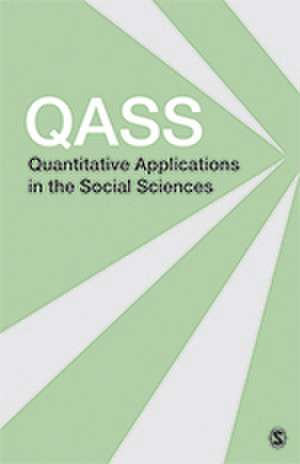Multiple Comparisons: Quantitative Applications in the Social Sciences, cartea 61
Autor Alan J. Klockars, Gilbert Saxen Limba Engleză Paperback – 23 noi 1986
Din seria Quantitative Applications in the Social Sciences
-
 Preț: 323.09 lei
Preț: 323.09 lei -
 Preț: 285.10 lei
Preț: 285.10 lei -
 Preț: 285.33 lei
Preț: 285.33 lei -
 Preț: 274.06 lei
Preț: 274.06 lei -
 Preț: 285.37 lei
Preț: 285.37 lei -
 Preț: 321.52 lei
Preț: 321.52 lei -
 Preț: 330.81 lei
Preț: 330.81 lei -
 Preț: 322.61 lei
Preț: 322.61 lei -
 Preț: 321.79 lei
Preț: 321.79 lei -
 Preț: 323.15 lei
Preț: 323.15 lei -
 Preț: 273.46 lei
Preț: 273.46 lei -
 Preț: 275.42 lei
Preț: 275.42 lei -
 Preț: 277.33 lei
Preț: 277.33 lei -
 Preț: 322.06 lei
Preț: 322.06 lei -
 Preț: 286.18 lei
Preț: 286.18 lei -
 Preț: 285.71 lei
Preț: 285.71 lei -
 Preț: 322.06 lei
Preț: 322.06 lei -
 Preț: 321.52 lei
Preț: 321.52 lei -
 Preț: 322.30 lei
Preț: 322.30 lei -
 Preț: 285.47 lei
Preț: 285.47 lei -
 Preț: 322.61 lei
Preț: 322.61 lei -
 Preț: 321.79 lei
Preț: 321.79 lei -
 Preț: 323.15 lei
Preț: 323.15 lei -
 Preț: 323.36 lei
Preț: 323.36 lei -
 Preț: 322.41 lei
Preț: 322.41 lei -
 Preț: 323.42 lei
Preț: 323.42 lei -
 Preț: 322.61 lei
Preț: 322.61 lei -
 Preț: 284.99 lei
Preț: 284.99 lei -
 Preț: 285.47 lei
Preț: 285.47 lei -
 Preț: 284.99 lei
Preț: 284.99 lei -
 Preț: 289.18 lei
Preț: 289.18 lei -
 Preț: 287.82 lei
Preț: 287.82 lei -
 Preț: 316.12 lei
Preț: 316.12 lei -
 Preț: 288.96 lei
Preț: 288.96 lei -
 Preț: 316.71 lei
Preț: 316.71 lei -
 Preț: 314.98 lei
Preț: 314.98 lei -
 Preț: 317.26 lei
Preț: 317.26 lei -
 Preț: 314.60 lei
Preț: 314.60 lei -
 Preț: 289.95 lei
Preț: 289.95 lei -
 Preț: 289.18 lei
Preț: 289.18 lei -
 Preț: 315.36 lei
Preț: 315.36 lei -
 Preț: 314.98 lei
Preț: 314.98 lei -
 Preț: 314.38 lei
Preț: 314.38 lei -
 Preț: 316.33 lei
Preț: 316.33 lei -
 Preț: 316.51 lei
Preț: 316.51 lei -
 Preț: 314.76 lei
Preț: 314.76 lei -
 Preț: 288.41 lei
Preț: 288.41 lei -
 Preț: 316.51 lei
Preț: 316.51 lei
Preț: 315.36 lei
Nou
Puncte Express: 473
Preț estimativ în valută:
60.35€ • 65.53$ • 50.70£
60.35€ • 65.53$ • 50.70£
Carte tipărită la comandă
Livrare economică 23 aprilie-07 mai
Preluare comenzi: 021 569.72.76
Specificații
ISBN-13: 9780803920514
ISBN-10: 0803920512
Pagini: 88
Dimensiuni: 140 x 216 x 6 mm
Greutate: 0.11 kg
Ediția:Expanded.
Editura: SAGE Publications
Colecția Sage Publications, Inc
Seria Quantitative Applications in the Social Sciences
Locul publicării:Thousand Oaks, United States
ISBN-10: 0803920512
Pagini: 88
Dimensiuni: 140 x 216 x 6 mm
Greutate: 0.11 kg
Ediția:Expanded.
Editura: SAGE Publications
Colecția Sage Publications, Inc
Seria Quantitative Applications in the Social Sciences
Locul publicării:Thousand Oaks, United States
Cuprins
Multiple Comparisons
A Priori Comparisons
Post Hoc Comparisons
Pairwise Methods
Post Hoc Comparisons
The Scheff>e Test
Multiple Comparisons in Factorial Designs
Unequal Sample Sizes
A Priori Comparisons
Post Hoc Comparisons
Pairwise Methods
Post Hoc Comparisons
The Scheff>e Test
Multiple Comparisons in Factorial Designs
Unequal Sample Sizes
Notă biografică
Many people do not automatically think of experimental design and statistics when they think of Education. In fact, major departments of Educational Psychology throughout the country have strong commitments to teaching and systematically exploring these topics and have consistently been leaders in the development of knowledge on how behavioral scientists can use the best possible practices when doing their research. It is in this spirit that I spend almost all of my teaching and research efforts on issues related to statistics and experimental design.
All of the classes that I (and others in the Measurement, Research Design and Statistics area) teach draw students from a wide variety of academic departments and colleges. This makes the course a lot more interesting for me and exposes our students to an array of issues not found in more narrowly defined programs. Our students learn about the issues in Nursing, Speech, Social Welfare, and many other disciplines making them more knowledgeable statistical consultants as they progress through the program.
Research that I do usually consists of asking what is the best way for researchers in the behavioral sciences to conduct their statistical analysis. I devote most of my time to finding best practices in answering specific questions within an analysis of variance. Using monte carlo simulation techniques, I will construct a simulated world in which I introduce differences between treatment groups. I then use each of the competing strategies to analyze the scores I have generated and record which methods correctly detect the difference. This is repeated a half million times to determine which strategy works best in the long run. A secondary research interest involves rating scales. Numerous factors influence how we attach meaning to potential responses on a rating scale. These include how many points there are and what anchors are attached to the positions. I am interested in how these characteristics can be manipulated to increase the information captured by the scale.
When I am not teaching or working on research I greatly enjoy writing musicals for my church¿s youth groups. Music has a wonderful structure and intricacy to it that in many ways is like the structure and intricacies of statistics.
All of the classes that I (and others in the Measurement, Research Design and Statistics area) teach draw students from a wide variety of academic departments and colleges. This makes the course a lot more interesting for me and exposes our students to an array of issues not found in more narrowly defined programs. Our students learn about the issues in Nursing, Speech, Social Welfare, and many other disciplines making them more knowledgeable statistical consultants as they progress through the program.
Research that I do usually consists of asking what is the best way for researchers in the behavioral sciences to conduct their statistical analysis. I devote most of my time to finding best practices in answering specific questions within an analysis of variance. Using monte carlo simulation techniques, I will construct a simulated world in which I introduce differences between treatment groups. I then use each of the competing strategies to analyze the scores I have generated and record which methods correctly detect the difference. This is repeated a half million times to determine which strategy works best in the long run. A secondary research interest involves rating scales. Numerous factors influence how we attach meaning to potential responses on a rating scale. These include how many points there are and what anchors are attached to the positions. I am interested in how these characteristics can be manipulated to increase the information captured by the scale.
When I am not teaching or working on research I greatly enjoy writing musicals for my church¿s youth groups. Music has a wonderful structure and intricacy to it that in many ways is like the structure and intricacies of statistics.
Descriere
Multiple Comparisons demonstrates the most important methods of investigating differences between levels of an independent variable within an experimental design. The authors review the analysis of variance and hypothesis testing and describe the dimensions on which multiple comparisons vary. A feature is the use made of a famous experiment by Solomon Asch on group conformity. The authors demonstrate the statistical power of each method against this one experimental question.






